TOYOTA FR-S 2015 (in English) Manual Online
Manufacturer: TOYOTA, Model Year: 2015, Model line: FR-S, Model: TOYOTA FR-S 2015Pages: 416, PDF Size: 5.25 MB
Page 81 of 416
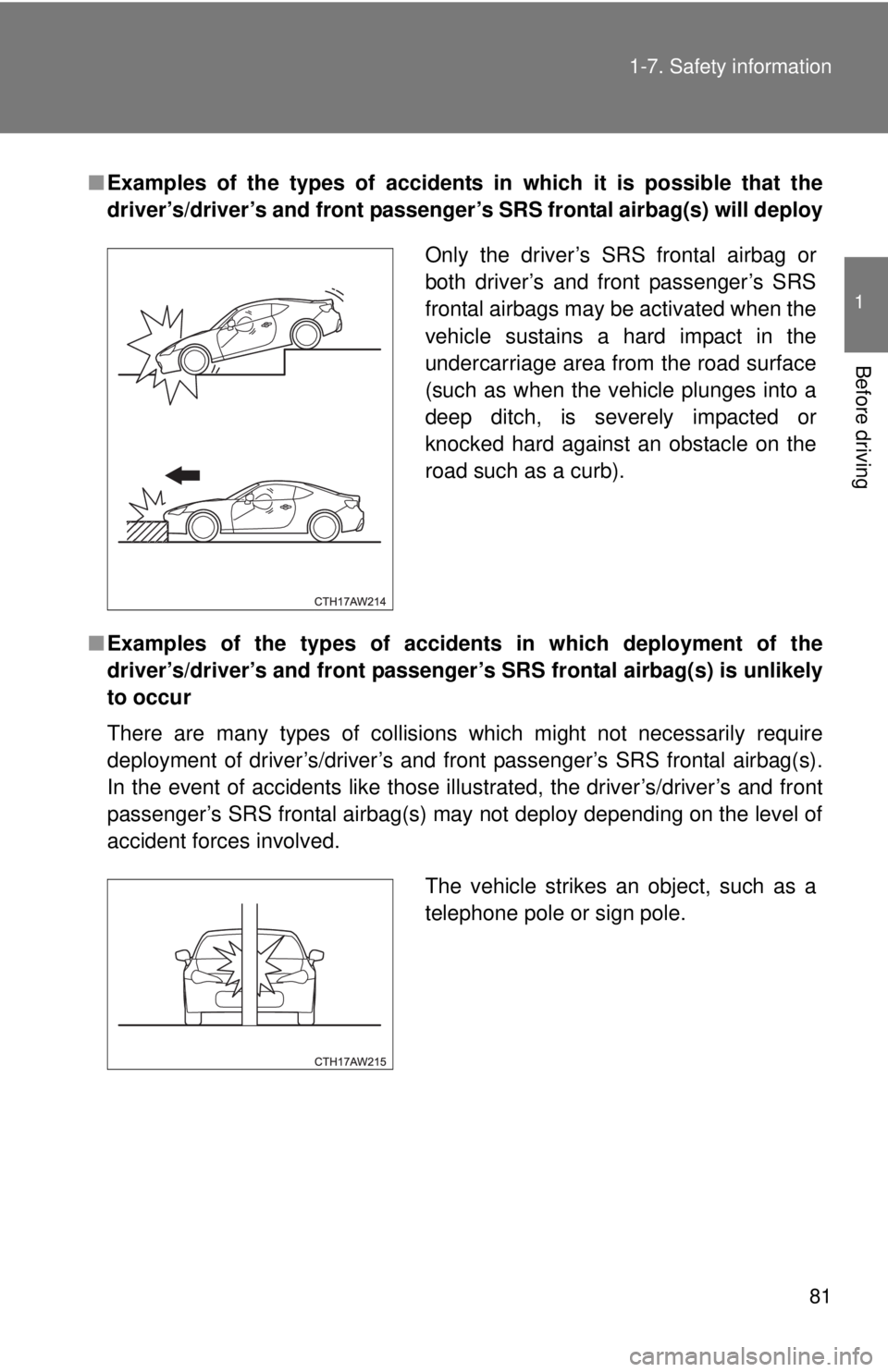
81
1-7. Safety information
1
Before driving
Ō¢Ā
Examples of the types of accidents in which it is possible that the
driverŌĆÖs/driverŌĆÖs and front passengerŌĆÖs SRS frontal airbag(s) will deploy
Ō¢Ā Examples of the types of accidents in which deployment of the
driverŌĆÖs/driverŌĆÖs and front passengerŌĆÖ s SRS frontal airbag(s) is unlikely
to occur
There are many types of collisions which might not necessarily require
deployment of driverŌĆÖs/driverŌĆÖs and front passengerŌĆÖs SRS frontal airbag(s).
In the event of accidents like those illustrated, the driverŌĆÖs/driverŌĆÖs and front
passengerŌĆÖs SRS frontal airbag(s) may not deploy depending on the level of
accident forces involved.
Only the driverŌĆÖs SRS frontal airbag or
both driverŌĆÖs and front passengerŌĆÖs SRS
frontal airbags may be activated when the
vehicle sustains a hard impact in the
undercarriage area from the road surface
(such as when the vehicle plunges into a
deep ditch, is severely impacted or
knocked hard against an obstacle on the
road such as a curb).
The vehicle strikes an object, such as a
telephone pole or sign pole.
Page 82 of 416
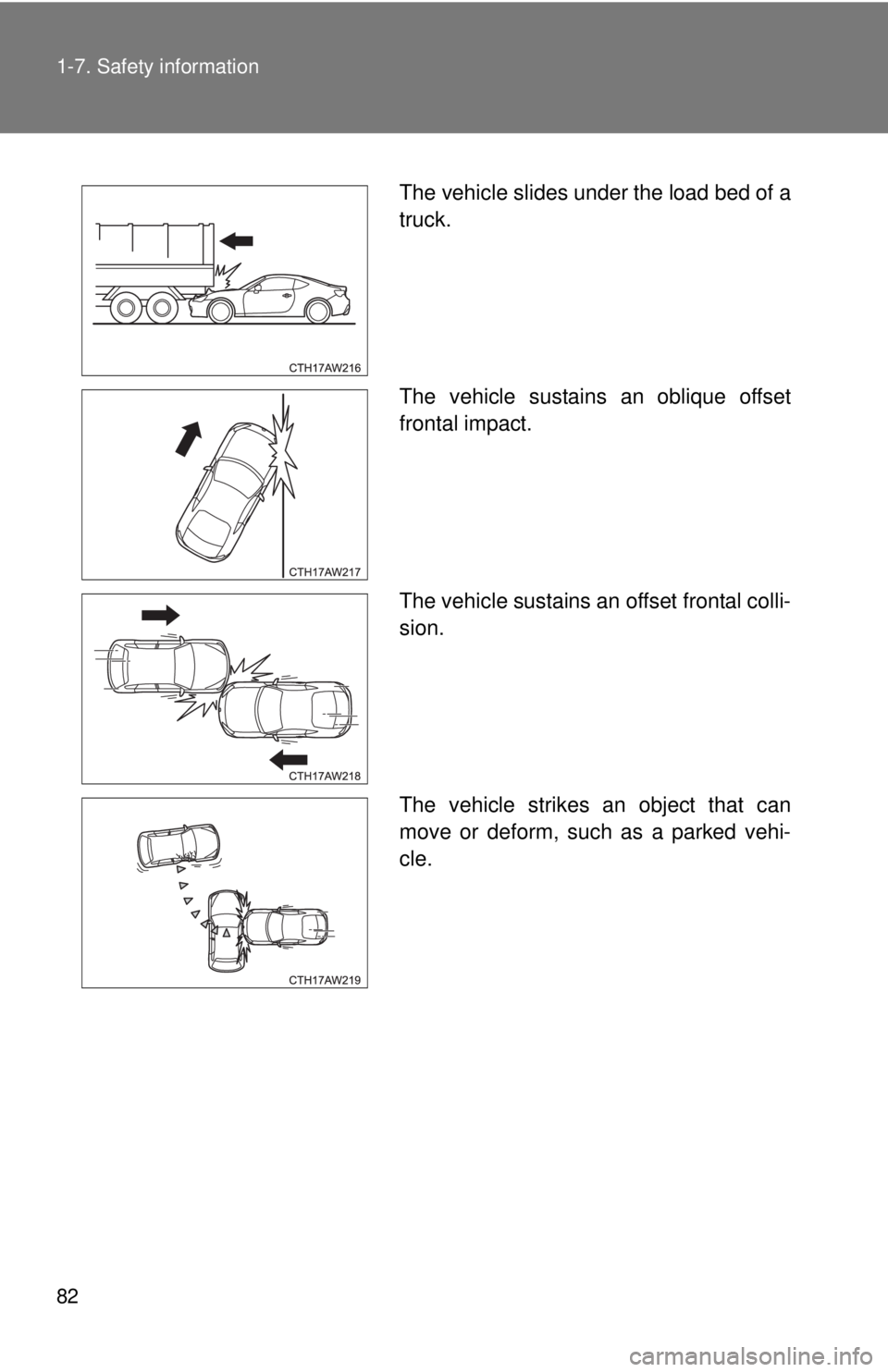
82 1-7. Safety information
The vehicle slides under the load bed of a
truck.
The vehicle sustains an oblique offset
frontal impact.
The vehicle sustains an offset frontal colli-
sion.
The vehicle strikes an object that can
move or deform, such as a parked vehi-
cle.
Page 83 of 416
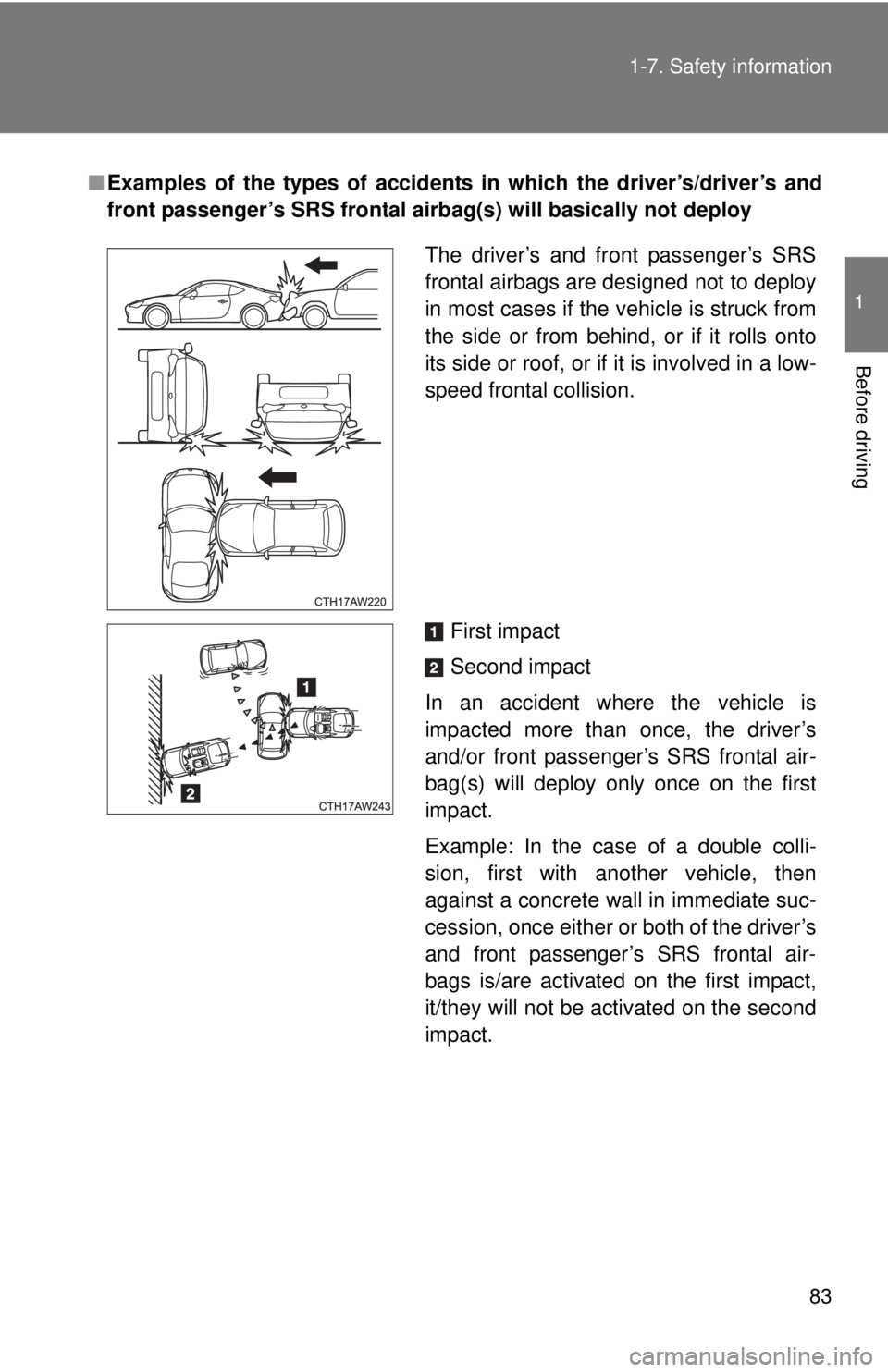
83
1-7. Safety information
1
Before driving
Ō¢Ā
Examples of the types of accidents in which the driverŌĆÖs/driverŌĆÖs and
front passengerŌĆÖs SRS frontal airb ag(s) will basically not deploy
The driverŌĆÖs and front passengerŌĆÖs SRS
frontal airbags are designed not to deploy
in most cases if the vehicle is struck from
the side or from behind, or if it rolls onto
its side or roof, or if it is involved in a low-
speed frontal collision.
First impact
Second impact
In an accident where the vehicle is
impacted more than once, the driverŌĆÖs
and/or front passengerŌĆÖs SRS frontal air-
bag(s) will deploy only once on the first
impact.
Example: In the case of a double colli-
sion, first with another vehicle, then
against a concrete wall in immediate suc-
cession, once either or both of the driverŌĆÖs
and front passengerŌĆÖs SRS frontal air-
bags is/are activated on the first impact,
it/they will not be activated on the second
impact.
Page 84 of 416

84 1-7. Safety information
CAUTION
Ō¢ĀIf the SRS airbags deploy
Do not touch the SRS airbag system components around the steering wheel
and dashboard with bare hands right after deployment. Doing so can cause
burns because the components can be very hot as a result of deployment.
Ō¢Ā Child restraint precautions
NEVER INSTALL A REARWARD FACING CHILD SEAT IN THE FRONT
PASSENGERŌĆÖS SEAT EVEN IF TH E FRONT PASSENGERŌĆÖS SRS FRON-
TAL AIRBAG IS DEACTIVATED. Be sure to install it in the REAR seat in a
correct manner. Also, it is strongly recommended that any forward facing
child seat or booster seat be installed in the REAR seat, and that even chil-
dren who have outgrown a child restraint system be also seated in the
REAR seat. This is because children sitting in the front passengerŌĆÖs seat
may be killed or severely injured should the front passengerŌĆÖs SRS frontal
airbag deploy. REAR seats are the safest place for children.
Page 85 of 416

85
1-7. Safety information
1
Before driving
SRS side airbag and SRS curtain shield airbag
The SRS side airbag is stored in the door side of each front seat
seatback, which bears an ŌĆ£SRS AIRBAGŌĆØ label.
In a moderate to severe side impa ct collision, the SRS side airbag on
the impacted side of the vehicl e deploys between the occupant and
the door panel and supplements the seat belt by reducing the impact
on the occupantŌĆÖs chest and waist. The SRS side airbag operates
only for front seat occupants.
The SRS curtain shield airbag on each side of the cabin is stored in
the roof side (bet ween the front pillar and a poi nt over the rear seat).
An ŌĆ£SRS AIRBAGŌĆØ mark is located at the top of each front and rear
pillar.
In a moderate to severe side impa ct collision, the SRS curtain shield
airbag on the impacted side of the vehicle deploys between the occu-
pant and the side window and supplem ents the seat belt by reducing
the impact on the occupantŌĆÖs head.
Page 86 of 416
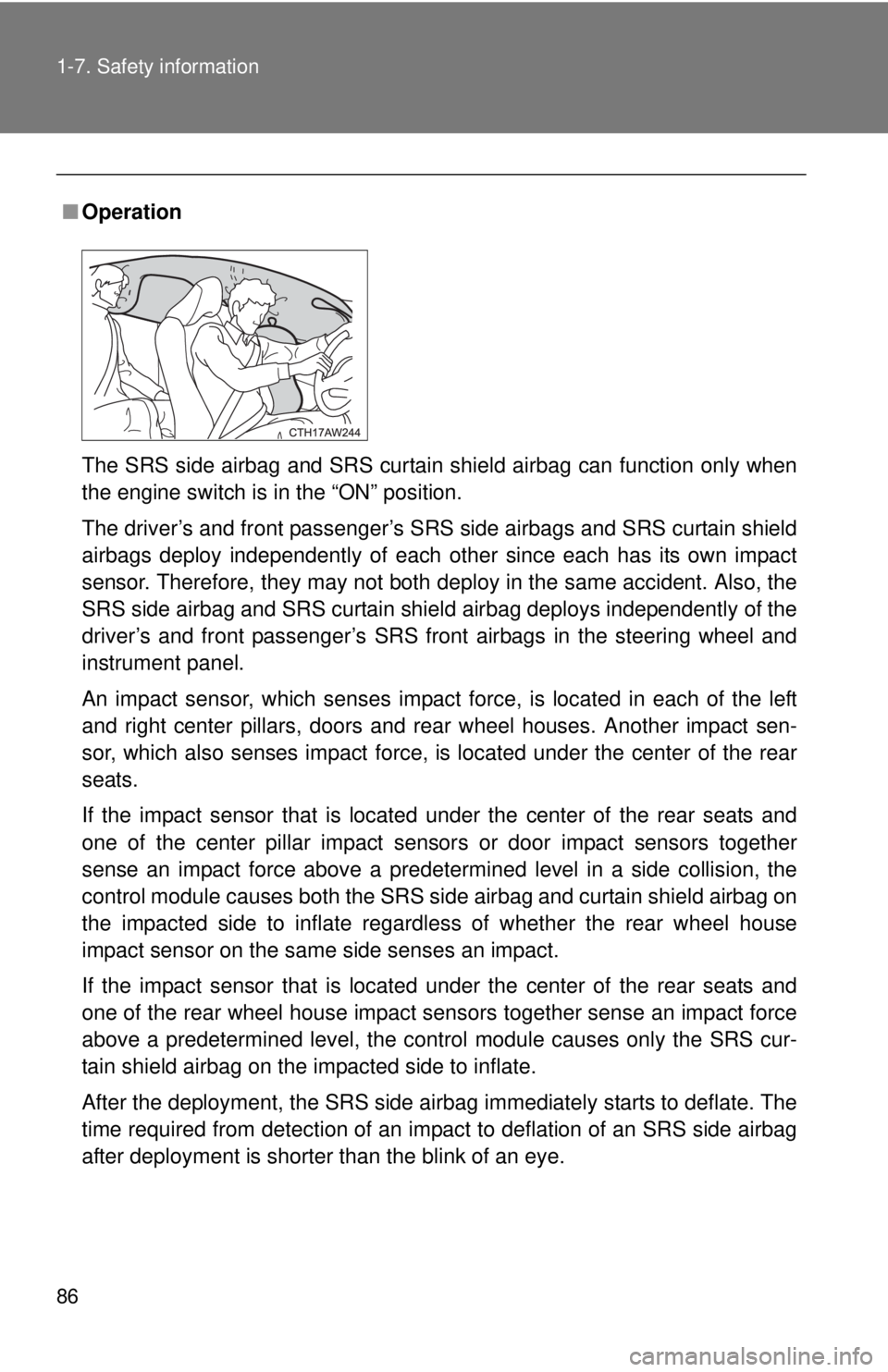
86 1-7. Safety information
Ō¢ĀOperation
The SRS side airbag and SRS curtain shield airbag can function only when
the engine switch is in the ŌĆ£ONŌĆØ position.
The driverŌĆÖs and front passengerŌĆÖs SRS side airbags and SRS curtain shield
airbags deploy independently of each other since each has its own impact
sensor. Therefore, they may not both deploy in the same accident. Also, the
SRS side airbag and SRS curtain shield airbag deploys independently of the
driverŌĆÖs and front passengerŌĆÖs SRS front airbags in the steering wheel and
instrument panel.
An impact sensor, which senses impact force, is located in each of the left
and right center pillars, doors and rear wheel houses. Another impact sen-
sor, which also senses impact force, is located under the center of the rear
seats.
If the impact sensor that is located under the center of the rear seats and
one of the center pillar impact sensors or door impact sensors together
sense an impact force above a predetermined level in a side collision, the
control module causes both the SRS side airbag and curtain shield airbag on
the impacted side to inflate regardless of whether the rear wheel house
impact sensor on the same side senses an impact.
If the impact sensor that is located under the center of the rear seats and
one of the rear wheel house impact sensors together sense an impact force
above a predetermined level, the control module causes only the SRS cur-
tain shield airbag on the impacted side to inflate.
After the deployment, the SRS side airbag immediately starts to deflate. The
time required from detection of an impact to deflation of an SRS side airbag
after deployment is shorter than the blink of an eye.
Page 87 of 416
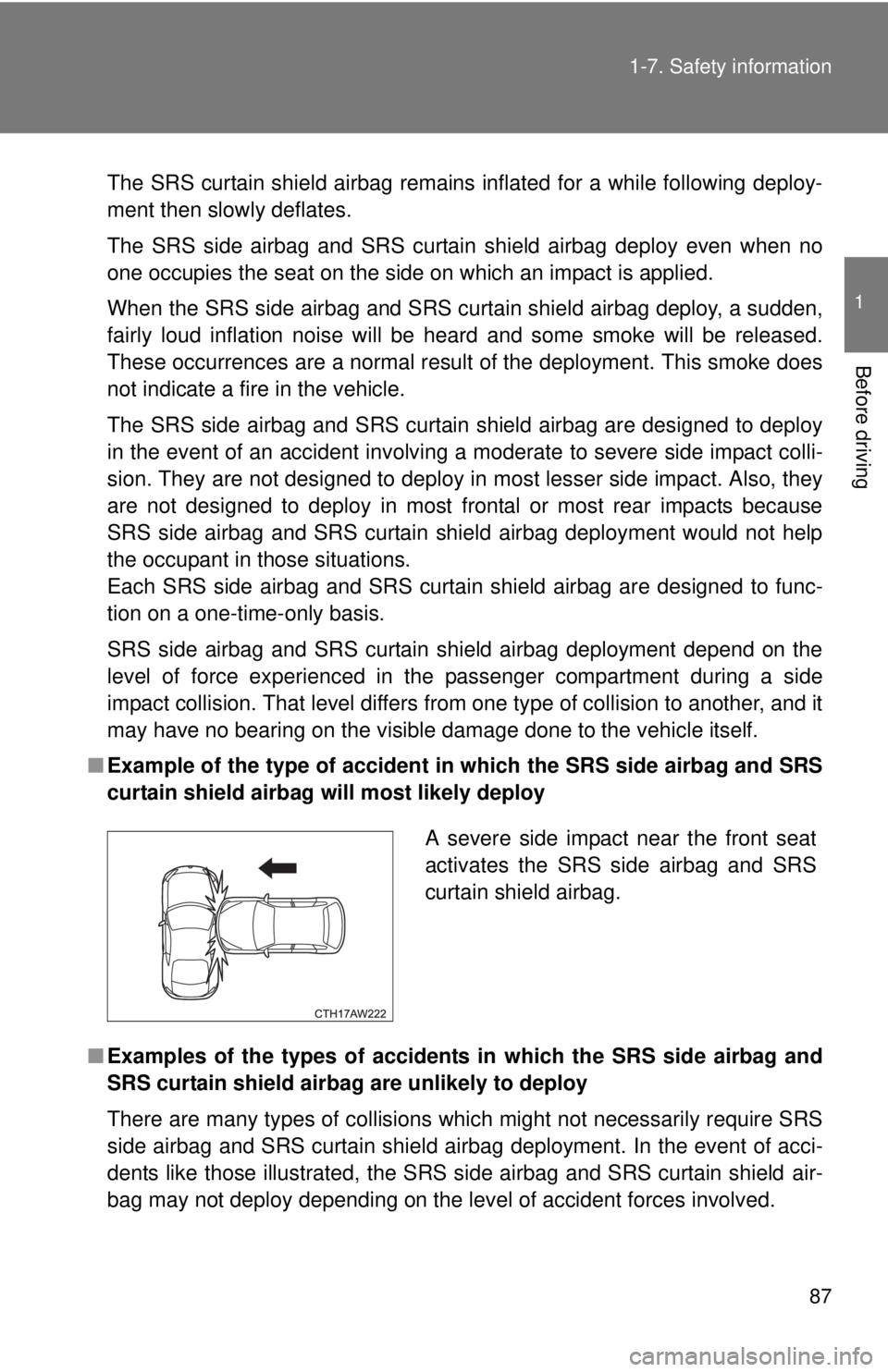
87
1-7. Safety information
1
Before driving
The SRS curtain shield airbag remains inflated for a while following deploy-
ment then slowly deflates.
The SRS side airbag and SRS curtain shield airbag deploy even when no
one occupies the seat on the side on which an impact is applied.
When the SRS side airbag and SRS curtain shield airbag deploy, a sudden,
fairly loud inflation noise will be heard and some smoke will be released.
These occurrences are a normal result of the deployment. This smoke does
not indicate a fire in the vehicle.
The SRS side airbag and SRS curtain shield airbag are designed to deploy
in the event of an accident involving a moderate to severe side impact colli-
sion. They are not designed to deploy in most lesser side impact. Also, they
are not designed to deploy in most frontal or most rear impacts because
SRS side airbag and SRS curtain shield airbag deployment would not help
the occupant in those situations.
Each SRS side airbag and SRS curtain shield airbag are designed to func-
tion on a one-time-only basis.
SRS side airbag and SRS curtain shield airbag deployment depend on the
level of force experienced in the passenger compartment during a side
impact collision. That level differs from one type of collision to another, and it
may have no bearing on the visible damage done to the vehicle itself.
Ō¢Ā Example of the type of accident in which the SRS side airbag and SRS
curtain shield airbag will most likely deploy
Ō¢Ā Examples of the types of accidents in which the SRS side airbag and
SRS curtain shield airbag are unlikely to deploy
There are many types of collisions which might not necessarily require SRS
side airbag and SRS curtain shield airbag deployment. In the event of acci-
dents like those illustrated, the SRS side airbag and SRS curtain shield
air-
bag may not deploy depending on the level of accident forces involved.
A severe side impact near the front seat
activates the SRS side airbag and SRS
curtain shield airbag.
Page 88 of 416
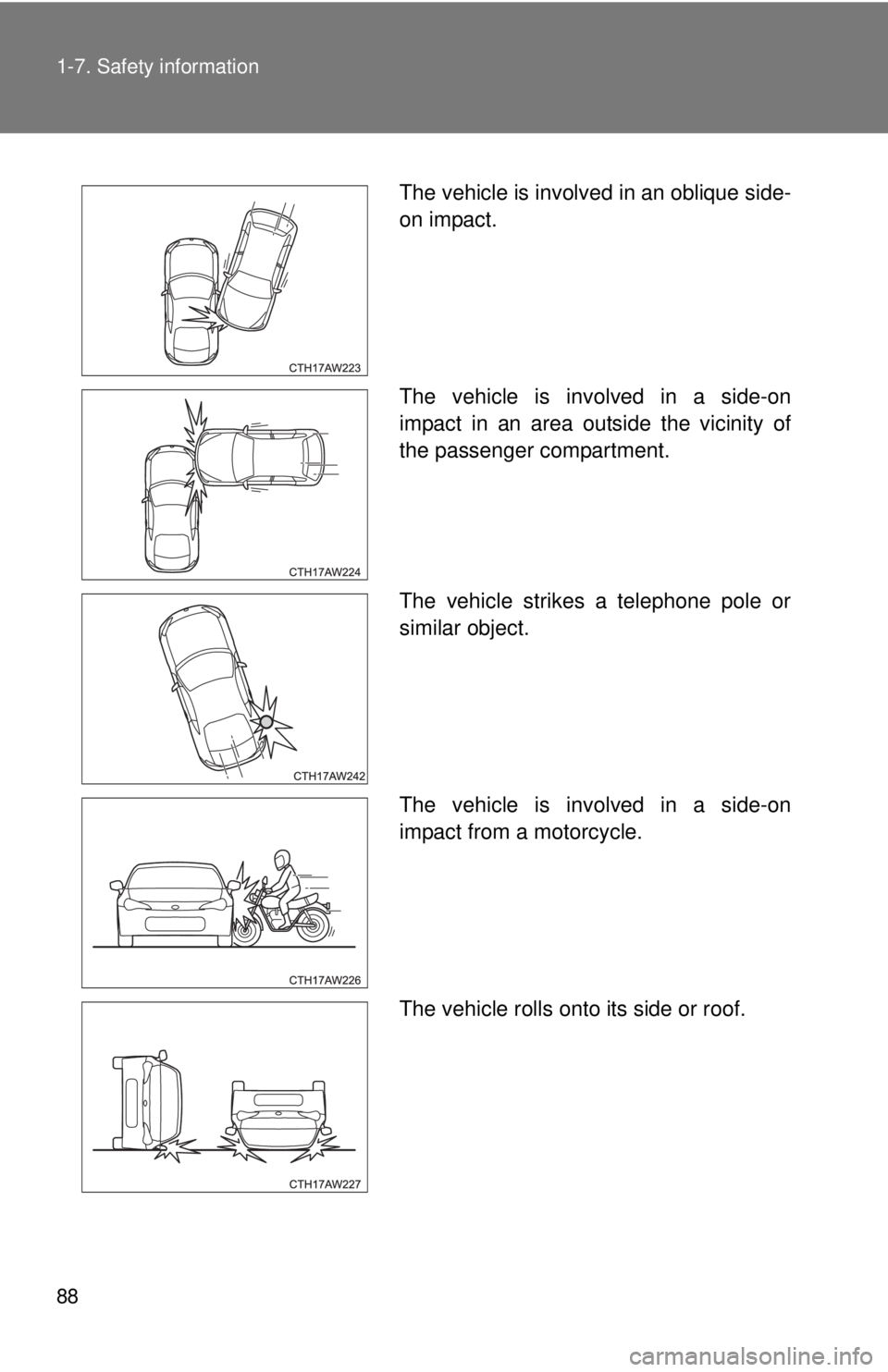
88 1-7. Safety information
The vehicle is involved in an oblique side-
on impact.
The vehicle is involved in a side-on
impact in an area outside the vicinity of
the passenger compartment.
The vehicle strikes a telephone pole or
similar object.
The vehicle is involved in a side-on
impact from a motorcycle.
The vehicle rolls onto its side or roof.
Page 89 of 416
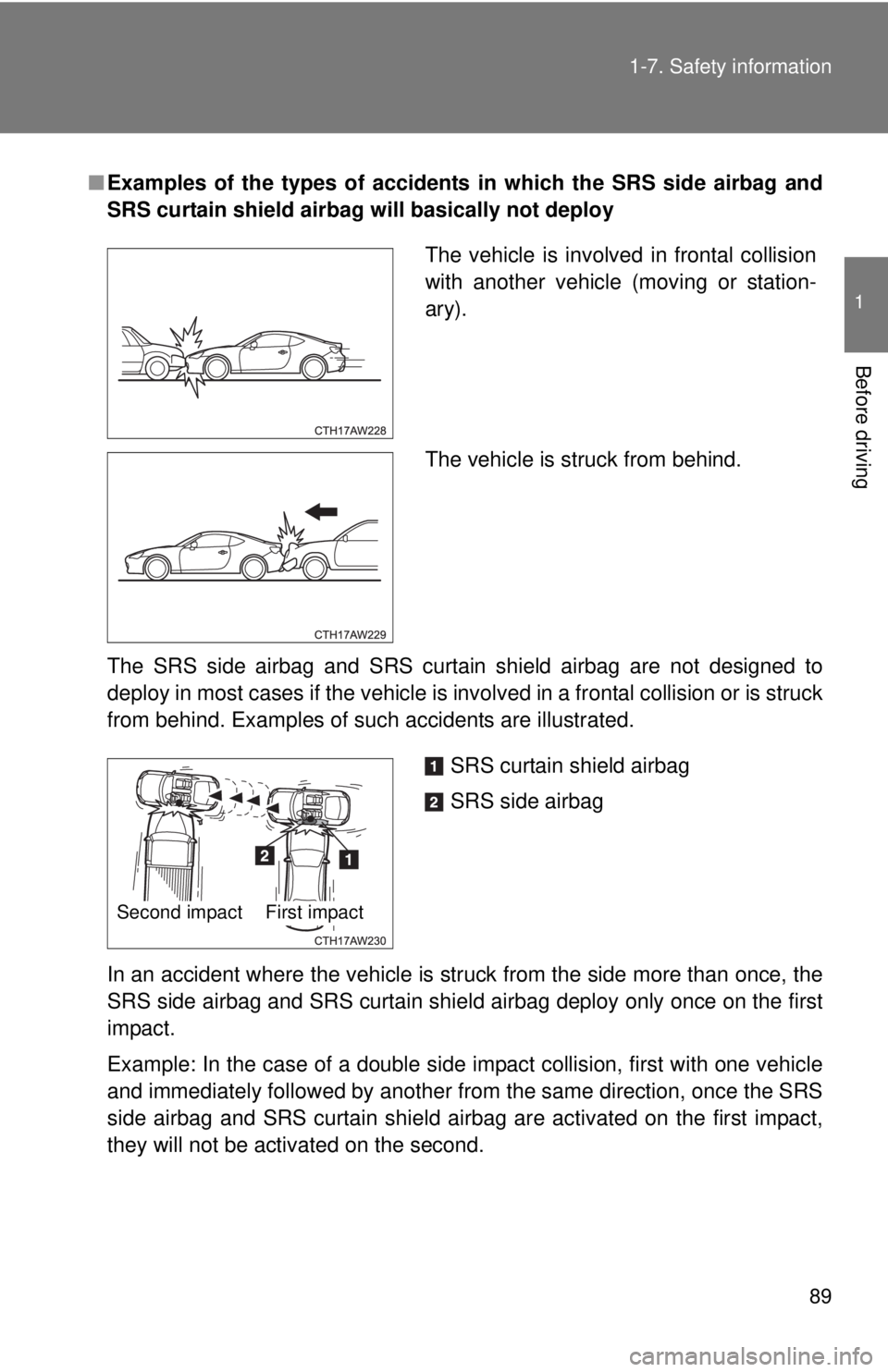
89
1-7. Safety information
1
Before driving
Ō¢Ā
Examples of the types of accidents in which the SRS side airbag and
SRS curtain shield airbag will basically not deploy
The SRS side airbag and SRS curtain shield airbag are not designed to
deploy in most cases if the vehicle is involved in a frontal collision or is struck
from behind. Examples of such accidents are illustrated.
In an accident where the vehicle is struck from the side more than once, the
SRS side airbag and SRS curtain shield airbag deploy only once on the first
impact.
Example: In the case of a double side impact collision, first with one vehicle
and immediately followed by another from the same direction, once the SRS
side airbag and SRS curtain shield airbag are activated on the first impact,
they will not be activated on the second.
The vehicle is involved in frontal collision
with another vehicle (moving or station-
ary).
The vehicle is struck from behind.
SRS curtain shield airbag
SRS side airbag
Second impact First impact
Page 90 of 416
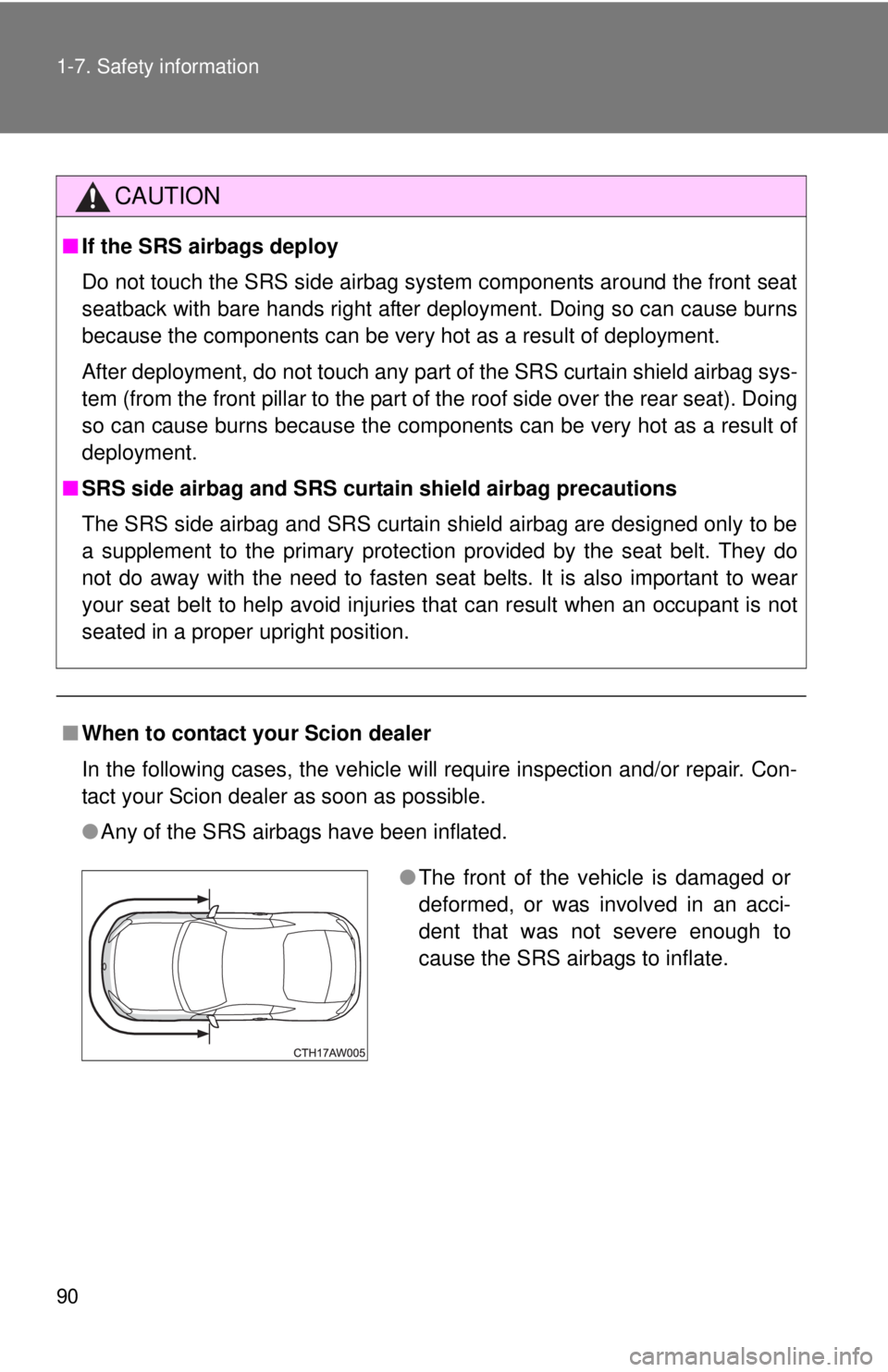
90 1-7. Safety information
CAUTION
Ō¢ĀIf the SRS airbags deploy
Do not touch the SRS side airbag system components around the front seat
seatback with bare hands right after deployment. Doing so can cause burns
because the components can be very hot as a result of deployment.
After deployment, do not touch any part of the SRS curtain shield airbag sys-
tem (from the front pillar to the part of the roof side over the rear seat). Doing
so can cause burns because the components can be very hot as a result of
deployment.
Ō¢Ā SRS side airbag and SRS curt ain shield airbag precautions
The SRS side airbag and SRS curtain shield airbag are designed only to be
a supplement to the primary protection provided by the seat belt. They do
not do away with the need to fasten seat belts. It is also important to wear
your seat belt to help avoid injuries that can result when an occupant is not
seated in a proper upright position.
Ō¢Ā When to contact your Scion dealer
In the following cases, the vehicle will require inspection and/or repair. Con-
tact your Scion dealer as soon as possible.
ŌŚÅAny of the SRS airbags have been inflated.
ŌŚÅThe front of the vehicle is damaged or
deformed, or was involved in an acci-
dent that was not severe enough to
cause the SRS airbags to inflate.